| 摘要 |
Within cold seep environments, the Vesicomyidae clam emerges as a prevalent species, distinguished by its symbiotic relationship with microorganisms housed within its organ gill. Given the extreme conditions and the symbiotic nature of this association, investigating the host's immune genes, particularly immune recognition receptors, is essential for understanding their role in facilitating host-symbiotic interactions. Three short peptidoglycan recognition proteins (PGRPs) were identified in the clam. AmPGRP-S1, -S2, and -S3 were found to possess conserved amidase binding sites and Zn2+ binding sites. Quantitative Real-time PCR (qRT-PCR) analysis revealed differential expression patterns among the PGRPs. AmPGRP-S1 and AmPGRP-S2 exhibited elevated expression levels in the gill, while AmPGRP-S3 displayed the highest expression in the adductor muscle. Functional experiments demonstrated that recombinant AmPGRP-S1, -S2, and -S3 (rAmPGRPs) exhibited binding capabilities to both L-PGN and D-PGN (peptidoglycan). Notably, rAmPGRP-S1 and -S2 possessed Zn2+-independent amidase activity, while rAmPGRP-S3 lacked this enzymatic function. rAmPGRPs were shown to bind to five different bacterial species. Among these, rAmPGRP-S1 inhibited Escherichia coli and Bacillus subtilis, while rAmPGRP-S2 and -S3 inhibited Bacillus subtilis in the absence of Zn2+. In the presence of Zn2+, rAmPGRP-S1 and -S2 exhibited enhanced inhibitory activity against Staphylococcus aureus or Bacillus subtilis. These findings suggest that AmPGRPs may play a pivotal role in mediating the interaction between the host and endosymbiotic bacteria, functioning as PGN and microbe receptors, antibacterial effectors, and regulators of host-microbe symbiosis. These results contribute to our understanding of the adaptive mechanisms of deep-sea organisms to the challenging cold seep environments.
|


 琼公网安备 46020102000014号
琼公网安备 46020102000014号
